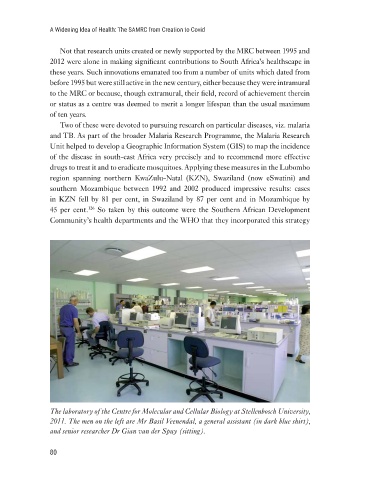Page 87 - A Widening Idea of Health and Health Research - The South African Medical Research Council from Creation to COVID
P. 87
A Widening Idea of Health: The SAMRC from Creation to Covid
Not that research units created or newly supported by the MRC between 1995 and
2012 were alone in making significant contributions to South Africa’s healthscape in
these years. Such innovations emanated too from a number of units which dated from
before 1995 but were still active in the new century, either because they were intramural
to the MRC or because, though extramural, their field, record of achievement therein
or status as a centre was deemed to merit a longer lifespan than the usual maximum
of ten years.
Two of these were devoted to pursuing research on particular diseases, viz. malaria
and TB. As part of the broader Malaria Research Programme, the Malaria Research
Unit helped to develop a Geographic Information System (GIS) to map the incidence
of the disease in south-east Africa very precisely and to recommend more effective
drugs to treat it and to eradicate mosquitoes. Applying these measures in the Lubombo
region spanning northern KwaZulu-Natal (KZN), Swaziland (now eSwatini) and
southern Mozambique between 1992 and 2002 produced impressive results: cases
in KZN fell by 81 per cent, in Swaziland by 87 per cent and in Mozambique by
45 per cent. So taken by this outcome were the Southern African Development
126
Community’s health departments and the WHO that they incorporated this strategy
The laboratory of the Centre for Molecular and Cellular Biology at Stellenbosch University,
2011. The men on the left are Mr Basil Veenendal, a general assistant (in dark blue shirt),
and senior researcher Dr Gian van der Spuy (sitting).
80

